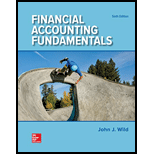
Concept explainers
1.
Compute cost of goods available for sale and the number of units available for sale.
1.
Explanation of Solution
Calculate cost of goods available for sale and the number of units available for sale.
| Cost of Goods Available For Sale | ||||
| Date | Particulars | Units (A) | Per Unit (B) | Amount (A× B) |
| May 1 | Beginning Inventory | 150 | $300 | $45,000 |
| May 6 | Purchase | 350 | $350 | $122,500 |
| May 17 | Purchase | 80 | $450 | $36,000 |
| May 25 | Purchase | 100 | $458 | $45,800 |
| Total | 680 | $249,300 | ||
Table (1)
Therefore, total cost of goods available for sale amount is $249,300, and the number of units available for sale is 680 units.
2.
Compute the number of units in ending inventory.
2.
Explanation of Solution
Calculate number of units in ending inventory as follows:
Working note:
Calculate cost of goods sold.
3.
Compute the cost assigned to ending inventory using the following methods:
- (a) FIFO
- (b) LIFO
- (c) Weighted average, and
- (d) Specific identification.
3.
Explanation of Solution
(a)
Compute the cost assigned to ending inventory using FIFO method as follows:
| Date | Particulars | Units (A) | Per Unit (B) | Amount (A× B) |
| May 25 | Ending Inventory | 100 | $458 | $45,800 |
| May 17 | Ending Inventory | 80 | $450 | $36,000 |
| May 6 | Ending Inventory | 20 | $350 | $7,000 |
| Total Ending inventory | 200 | $88,800 |
Table (2)
(b)
Compute the cost assigned to ending inventory using LIFO method as follows:
| Date | Particulars | Units (A) | Per Unit (B) | Amount (A× B) |
| May 1 | Ending Inventory | 150 | $300 | $45,000 |
| May 6 | Ending Inventory | 50 | $350 | $17,500 |
| Total Ending inventory | 200 | $62,500 |
Table (3)
(c)
Compute the cost assigned to ending inventory using weighted average method as follows:
Working note:
Calculate weighted average per unit.
(d)
Compute the cost assigned to ending inventory using specific identification method as follows:
| Date | Particulars | Units (A) | Per Unit (B) | Amount (A× B) |
| May 1 | Ending Inventory | 70 | $300 | $21,000 |
| May 6 | Ending Inventory | 50 | $350 | $17,500 |
| May 17 | Ending Inventory | 80 | $450 | $36,000 |
| Total Ending inventory | 400 | $74,500 |
Table (4)
4.
Compute gross profit earned by the company for each of the four costing methods in part 3.
4.
Explanation of Solution
Calculate gross profit earned by the company for each of the four costing methods as follows:
| Particulars | FIFO | LIFO | Weighted Average | Specific Identification |
| Sales | $636,000 | $636,000 | $636,000 | $636,000 |
| Less: Cost of goods sold | $160,500 | $186,800 | $175,976 | $174,800 |
| Gross profit | $475,500 | $449,200 | $460,024 | $461,200 |
Table (5)
Working notes:
Calculate sales amount.
Calculate cost of goods sold.
| Particulars | FIFO | LIFO | Weighted Average | Specific Identification |
| Cost of goods available for sale | $249,300 | $249,300 | $249,300 | $249,300 |
| Less: Ending Inventory | $88,800 | $62,500 | $73,324 | $74,500 |
| Cost of goods sold | $160,500 | $186,800 | $175,976 | $174,800 |
Table (6)
5.
Identify the method of inventory costing which the manager will prefer, if he earns a bonus based on a percentage of gross profit.
5.
Explanation of Solution
The Manger would prefer a FIFO method, because comparing to all four methods FIFO method only giving more income. If he prefers, FIFO method means, he will get a bonus based on a percentage of gross profit.
Want to see more full solutions like this?
Chapter 5 Solutions
Financial Accounting Fundamentals
- I am trying to find the accurate solution to this financial accounting problem with appropriate explanations.arrow_forwardI need help finding the correct solution to this financial accounting problem with valid methods.arrow_forwardCan you help me solve this general accounting problem with the correct methodology?arrow_forward
- I need help with this financial accounting problem using proper accounting guidelines.arrow_forwardPlease provide the solution to this general accounting question using proper accounting principles.arrow_forwardI need help finding the accurate solution to this general accounting problem with valid methods.arrow_forward
- When incorporating his sole proprietorship, Joe transfers all of its assets and liabilities. Included in the $30,000 of liabilities assumed by the corporation is $500 that relates to a personal expenditure. Under these circumstances, the entire $30,000 will be treated as boot. / Provide explanation please a. True b. Falsearrow_forwardIn determining whether § 357(c) applies, assess whether the liabilities involved exceed the bases of all assets a shareholder transfers to the corporation./ Provide explanation please. a. True b. Falsearrow_forwardI will unhelpful if wrong.arrow_forward

 AccountingAccountingISBN:9781337272094Author:WARREN, Carl S., Reeve, James M., Duchac, Jonathan E.Publisher:Cengage Learning,
AccountingAccountingISBN:9781337272094Author:WARREN, Carl S., Reeve, James M., Duchac, Jonathan E.Publisher:Cengage Learning, Accounting Information SystemsAccountingISBN:9781337619202Author:Hall, James A.Publisher:Cengage Learning,
Accounting Information SystemsAccountingISBN:9781337619202Author:Hall, James A.Publisher:Cengage Learning, Horngren's Cost Accounting: A Managerial Emphasis...AccountingISBN:9780134475585Author:Srikant M. Datar, Madhav V. RajanPublisher:PEARSON
Horngren's Cost Accounting: A Managerial Emphasis...AccountingISBN:9780134475585Author:Srikant M. Datar, Madhav V. RajanPublisher:PEARSON Intermediate AccountingAccountingISBN:9781259722660Author:J. David Spiceland, Mark W. Nelson, Wayne M ThomasPublisher:McGraw-Hill Education
Intermediate AccountingAccountingISBN:9781259722660Author:J. David Spiceland, Mark W. Nelson, Wayne M ThomasPublisher:McGraw-Hill Education Financial and Managerial AccountingAccountingISBN:9781259726705Author:John J Wild, Ken W. Shaw, Barbara Chiappetta Fundamental Accounting PrinciplesPublisher:McGraw-Hill Education
Financial and Managerial AccountingAccountingISBN:9781259726705Author:John J Wild, Ken W. Shaw, Barbara Chiappetta Fundamental Accounting PrinciplesPublisher:McGraw-Hill Education





